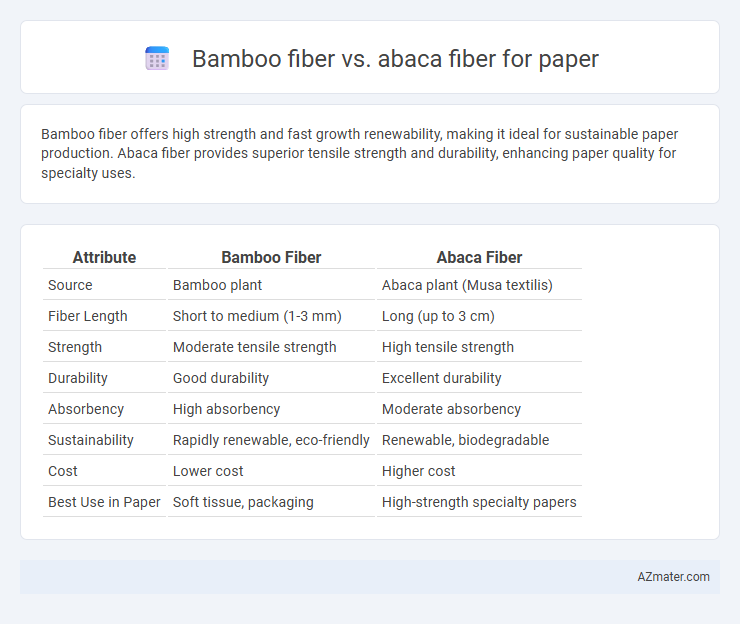Bamboo fiber offers high strength and fast growth renewability, making it ideal for sustainable paper production. Abaca fiber provides superior tensile strength and durability, enhancing paper quality for specialty uses.
Table of Comparison
| Attribute | Bamboo Fiber | Abaca Fiber |
|---|---|---|
| Source | Bamboo plant | Abaca plant (Musa textilis) |
| Fiber Length | Short to medium (1-3 mm) | Long (up to 3 cm) |
| Strength | Moderate tensile strength | High tensile strength |
| Durability | Good durability | Excellent durability |
| Absorbency | High absorbency | Moderate absorbency |
| Sustainability | Rapidly renewable, eco-friendly | Renewable, biodegradable |
| Cost | Lower cost | Higher cost |
| Best Use in Paper | Soft tissue, packaging | High-strength specialty papers |
Introduction to Bamboo and Abaca Fibers
Bamboo fiber, derived from the fast-growing bamboo plant, is valued for its strength, flexibility, and eco-friendly properties, making it a popular choice in sustainable paper production. Abaca fiber, sourced from the Musa textilis plant native to the Philippines, is renowned for its exceptional durability, resistance to water, and natural fibers ideal for specialty paper products. Both fibers offer unique structural qualities that influence the texture, strength, and biodegradability of paper.
Botanical Origins and Growth Conditions
Bamboo fiber, derived from fast-growing grass species in the Poaceae family, thrives in warm, humid climates with abundant rainfall, making it highly renewable and suitable for sustainable paper production. Abaca fiber originates from Musa textilis, a banana relative native to the Philippines, requiring tropical temperatures and well-drained soil for optimal growth. Both fibers offer natural strength and flexibility, but their distinct botanical origins and growth conditions influence fiber quality and environmental impact in papermaking.
Fiber Extraction Processes
Bamboo fiber extraction for paper involves mechanical processing, where bamboo stalks are crushed, steamed, and beaten to separate fibers, yielding long, strong fibers ideal for durable paper production. Abaca fiber extraction utilizes a manual or mechanical stripping method called decortication, which removes the outer bark from the plant, followed by washing and drying to produce fibers known for their high tensile strength and resistance to moisture. Both fibers undergo pulping processes, but bamboo offers faster extraction cycles, whereas abaca requires more labor-intensive steps but provides superior fiber quality for specialty papers.
Physical and Chemical Properties Comparison
Bamboo fiber exhibits higher tensile strength and elongation at break compared to Abaca fiber, making it more durable for paper applications. Chemically, Bamboo fiber contains a greater cellulose content (around 40-50%) with lower lignin levels (approximately 20-25%), enhancing pulp quality and smoothness, whereas Abaca fiber has higher hemicellulose content and lignin, contributing to its natural rigidity but lower flexibility. The moisture regain of Bamboo fiber is approximately 10-12%, slightly less than Abaca fiber's 11-13%, influencing drying time and paper stiffness in industrial processing.
Strength and Durability in Papermaking
Bamboo fiber exhibits high tensile strength and excellent tear resistance, making it ideal for durable paper products such as packaging and currency notes. Abaca fiber is renowned for its exceptional wet strength and long fiber length, contributing to enhanced paper durability and resistance to wear, especially in specialty papers and tea bags. Both fibers offer superior strength properties, but abaca's natural lignin content provides additional resilience in humid conditions, whereas bamboo delivers consistent durability with fast renewability.
Environmental Impact and Sustainability
Bamboo fiber offers a highly sustainable option for paper production due to its rapid growth rate, requiring minimal water and no pesticides, which significantly reduces environmental degradation compared to traditional fibers. Abaca fiber, derived from banana plants native to the Philippines, is renewable and biodegradable, supporting biodiversity and local economies but requires more extensive land use. Both fibers contribute to lowering carbon footprints, yet bamboo's superior carbon sequestration and faster renewable cycle position it as a more eco-friendly choice in sustainable paper manufacturing.
Paper Quality: Texture, Whiteness, and Printability
Bamboo fiber produces paper with a smoother texture and higher natural whiteness, enhancing ink absorption and resulting in sharp, vibrant print quality. Abaca fiber offers superior tensile strength, contributing to durable paper but with a coarser texture and lower brightness that can affect print clarity. Paper made from bamboo fiber is generally preferred for high-quality printing applications due to its consistent texture and whiteness.
Cost Analysis and Market Availability
Bamboo fiber offers a cost-effective raw material for paper production due to its rapid growth cycle and high yield per hectare, leading to lower procurement costs compared to abaca fiber, which is typically more expensive owing to its labor-intensive extraction process and limited cultivation regions. Market availability of bamboo fiber is more widespread and consistent worldwide, fueled by extensive plantations in Asia and increasing adoption in sustainable industries, whereas abaca fiber supply remains niche, primarily concentrated in the Philippines with restricted export volumes. Paper manufacturers seeking scalable, affordable fiber sources often favor bamboo for its abundant supply and cost advantages, while abaca is reserved for specialty papers requiring superior strength and durability despite higher material costs.
Common Applications in the Paper Industry
Bamboo fiber is widely used in the paper industry for producing high-quality printing and writing paper due to its long fibers, which enhance strength and durability. Abaca fiber, known for its exceptional tensile strength and resistance to saltwater, is commonly utilized in specialty papers such as currency, tea bags, and banknotes. Both fibers contribute to eco-friendly paper production, with bamboo favored for large-scale pulp production and abaca prized for its premium, durable paper applications.
Future Trends and Innovations in Fiber-Based Paper
Bamboo fiber and abaca fiber are driving significant innovations in sustainable paper production due to their renewable nature and superior strength characteristics. Advances in enzymatic processing and nano-cellulose extraction from both fibers are enabling enhanced paper durability and reduced reliance on chemical treatments. Future trends highlight a shift towards hybrid fiber composites combining bamboo and abaca to optimize cost-efficiency, biodegradability, and mechanical performance in specialty paper products.

Infographic: Bamboo fiber vs Abaca fiber for Paper
 azmater.com
azmater.com